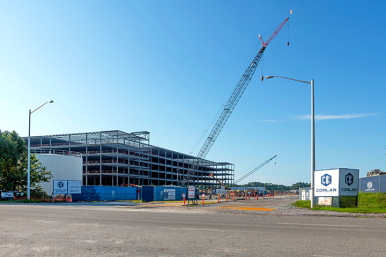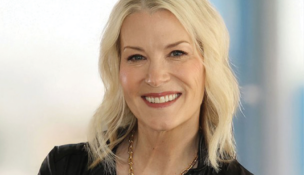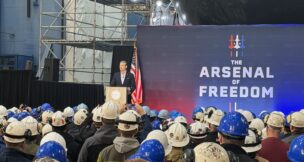Amazing race
North America’s largest industrial tenant keeps growing

An Amazon employee prepares a package for shipment at the e-commerce giant’s 650,000-square-foot non-sortable fulfillment center in Henrico County, which opened in 2023. Photo courtesy Amazon.com

An Amazon employee prepares a package for shipment at the e-commerce giant’s 650,000-square-foot non-sortable fulfillment center in Henrico County, which opened in 2023. Photo courtesy Amazon.com
Amazing race
North America’s largest industrial tenant keeps growing
Virginia is reaping thousands of jobs and huge tax revenues as Amazon.com revamps its U.S. delivery network. The e-commerce giant is opening major distribution centers and sorting facilities across the commonwealth as part of its nationwide strategy to get goods to consumers faster and stay one step ahead of competitors like Walmart and Target that have seen a surge in online orders, as well as newer online upstarts Shein and Temu.
Already the largest industrial tenant in North America, Amazon has leased, purchased or announced plans for more than 16 million square feet of new warehouse space across the nation this year as part of its distribution network upgrade. Traditionally relying on a centralized network, the Seattle-based company with its East Coast headquarters in Arlington County is developing nine regional distribution networks across the country to ensure customers can obtain products quickly from nearby fulfillment centers. Doing so necessitates placing inventory in more warehouses nationwide.
“Amazon’s network is continually optimized to position products close to the demand location, requiring additional investments when activity in a region reaches certain thresholds,” explains Jason El Koubi, president and CEO of the Virginia Economic Development Partnership.
Across Virginia, more than 30 warehouses, 11 fulfillment and sortation centers and 16 delivery stations bear the Amazon brand. The online retailer opened its first Virginia fulfillment facility in Sterling in 2006 and continues to expand across the state, investing more than $109 billion and creating more than 36,000 jobs since 2010. Additionally, Amazon has contributed more than $72 billion to the state’s gross domestic product. Those investments have helped solidify Virginia’s position as one of North America’s prime supply chain hubs.
“We have a very strong and positive relationship with Amazon,” says El Koubi. “Amazon plays a very important role in the ecosystem of distribution and supply chain operations in Virginia and is one of the core providers of logistics-related job growth. It has a very sophisticated network that continues to be optimized to position products close to demand centers.”
Big presence
In 2021, Amazon chose Stafford County as one of its East Coast hubs where items from third-party vendors are sorted, repacked and sent to other distribution centers. The 630,000-square-foot cross-dock fulfillment center in the Northern Virginia Gateway industrial park opened in 2022, bringing 500 jobs to the Fredericksburg and Stafford region.
Virginia’s newest Amazon facilities — a 650,000-square-foot robotics fulfillment center in Henrico County that created more than 1,000 full-time jobs and a 1 million-square-foot non-sortable fulfillment center in Augusta County with 500 jobs — opened in 2023. A last-mile distribution center in Roanoke is expected to be up and running by late this year.
Also set to open in time for the holiday season is a 219,000-square-foot Virginia Beach delivery station, with an adjacent 650,000-square-foot robotics fulfillment center coming online in 2025. Combined, Amazon is investing $350 million in the facilities, which are expected to bring more than 1,000 jobs to Hampton Roads. They join other Amazon sites in Hampton Roads, including the company’s first robotics fulfillment center in Virginia, a $230 million, 3.8 million-square-foot, five-story robotics behemoth in Suffolk that lays claim as the state’s second largest building behind the Pentagon, and a $50 million, 650,000-square-foot fulfillment center and career center in Chesapeake. Amazon’s Suffolk facility employs about 1,500 workers, while the Chesapeake center has about 1,000 employees.
The Hampton Roads Alliance, the regional economic development organization, has worked with Amazon since 2020, when the Fortune Global 500 online retailer and tech company announced it would build the distribution centers in Suffolk and Chesapeake.
“In just a few short years, Amazon has become one of Hampton Roads’ major employers,” says Alliance President and CEO Doug Smith. “The company has proven to be a strong corporate partner and an ally in recruiting and retaining the next generation of talent.”
In addition, Amazon operates three Prime Now fulfillment centers in Virginia Beach, Springfield and Richmond, which offer one- and two-hour deliveries for Amazon Prime customers in Virginia. Amazon also has 16 Whole Foods Markets and five Amazon Fresh outlets across the commonwealth.
Most notable about the company’s Virginia presence is its $2.5 billion East Coast headquarters, HQ2, which it opened in Arlington in 2023.
Last year, Amazon also announced that it will double its investment in data centers so far across Virginia, spending another $35 billion by 2040 and adding at least 1,000 jobs.
In all, Amazon has 39,000 full- and part-time employees in Virginia. The retailer also works with more than 11,000 Virginia-based independent sellers — mostly small and medium-sized businesses.
‘Huge impact’
Virginia’s pro-business environment drew Amazon to the commonwealth.
“Strong local, state and regional support have made Virginia attractive to Amazon,” says Amazon spokesperson Sam Fisher, adding that the company is constantly exploring new locations when deciding where to develop sites to best serve customers.
“Virginia is a great state to do business, and the support we’ve received from day one has been key to our ability to invest, grow, hire and innovate on behalf of our customers.”

Amazon’s Henrico Fulfillment Center, built on 199 acres adjacent to Richmond International Raceway, brought more than 1,000 jobs to Central Virginia.
“This has had a huge impact for us,” says Henrico Economic Development Authority Executive Director Anthony Romanello. “Amazon has done everything they said they would do in terms of investments and hiring.”
The largest building in Central Virginia, the fulfillment center spans 2.7 million square feet and is Amazon’s second robotics center in Virginia. The company worked with Texas-based Hillwood Development to secure the property, which was purchased for $7.7 million. Hillwood frequently joins Amazon in warehouse development projects nationwide.
A pandemic-fueled increase in e-commerce propelled much of Amazon’s expansion, with the company snatching up 40% of U.S. warehouse space in 2020.
In Northern Virginia, Amazon’s growth has helped keep industrial sector vacancy rates in the low- to mid-single digits, says Nate Edwards, Cushman and Wakefield’s senior director of Washington, D.C., metro research. By contrast, more than 20% of office space in the D.C. region sits vacant as significant numbers of employees have shifted to remote and hybrid work.
“COVID was an excellent thing for Amazon and industrial brokers,” says Cushman & Wakefield Executive Director Jon Lawrence, who notes that skyrocketing demand for industrial space has led to double and triple rental rate increases. “Amazon has eaten up a lot of warehouse space in Northern Virginia. I’ve been doing this for 37 years and have never seen anything like the last four years.”
As the largest industrial tenant in Northern Virginia, Amazon has inventory in about a dozen 60,000-, 80,000- and 100,000-square-foot buildings in Northern Virginia. “There’s not 1 million square feet in one building but broken into a bunch of buildings in Ashburn, Chantilly and Manassas,” Lawrence says. “There’s no zoned land left in Northern Virginia to build warehouses, and supply is incredibly limited.”
Competitors have been watching Amazon’s growth and trying to emulate it. For example, online furniture and home décor retailer Wayfair has a large distribution center in Manassas. “Everyone sees what they’re doing and figures out how to do it as well,” Lawrence says, “but it’s safe to say no one is close to being as successful as Amazon.”
However, he believes that Amazon will eventually put the brakes on its warehouse growth. “Nobody can keep doubling or tripling their business forever. There will be a pause. At some point in time, they have to have enough warehouses to distribute products in the next 24 hours.”
‘Success begets success’
More than 4,600 companies, spanning warehousing and storage, road, rail, air and maritime freight transport make up Virginia’s diverse logistics ecosystem for distribution and supply chain operations, notes El Koubi. Other leading logistics companies, such as FedEx, UPS, DHL, Patton Logistics, InterChange Group, and Lineage Logistics, have also made significant investments in storage and distribution facilities in Virginia.
Those investments are the upshot of Virginia assets such as the Port of Virginia and Dulles International Airport, as
well as the state’s strategic mid-Atlantic location. “Companies can get to 75% of the U.S. population in two days or less by road,” El Koubi notes. “As the nation’s mean center of population has shifted to the South over the past decade, that
gives Virginia an advantage.”
Hampton Roads has always been a hub for logistics companies, says Smith. “The region’s labor force has plentiful talent for companies looking to distribute their goods both domestically and internationally.” He adds that much of the region’s current industrial development has focused on western Hampton Roads, where Amazon, Target and Ace Hardware have opened distribution centers.
Demand for industrial and distribution space has spiked in the region. CoStar Group, a major provider of commercial real estate data and analytics, noted in February that less than 4% of industrial space is available in Hampton Roads, one of the tightest availability rates nationally. Demand has led to multiple speculative projects, with industrial construction seeing a 63% jump in the market’s pipeline during the first quarter of 2024.
Currently, 4.2 million square feet of industrial space are under construction, including Amazon’s Virginia Beach fulfillment center. According to CoStar, this is only the third time in a decade that more than 2 million square feet of distribution space has broken ground in a single quarter.
“In this case, success begets success as industrial developers have stepped up to meet the ever-increasing demand,” Smith says.
As e-commerce mushroomed over the past few years, record absorption followed, says Geoff Poston, a Cushman & Wakefield | Thalhimer senior vice president who leads the company’s Hampton Roads industrial group. “The industry has been on a crazy run the past four or five years,” Poston says. “E-commerce is a large part of what has driven leasing and absorption activity. Developers were racing to build more space.”
Poston adds that the industry is still doing very well but not at the same historic rates as over the past three years, a byproduct of what he calls a COVID hangover effect. “All that demand came at one time,” he says. “Retailers sold two to three years of inventory in one year. Leasing rates rose dramatically, and properties were being leased. All of a sudden, demand among tenants cooled off.”
Still, logistics companies like Amazon are continuing to invest and expand in Virginia.
“We see a lot of potential for growth,” El Koubi says, noting that VEDP has made logistics one of its target economic growth sectors.
“Logistics is one of the most rapidly growing sectors in Virginia and a sector in which Virginia is at an advantage,” he adds. “One of Virginia’s great strengths is our economic landscape is very diverse. Almost any kind of business operation can excel here.”
>















